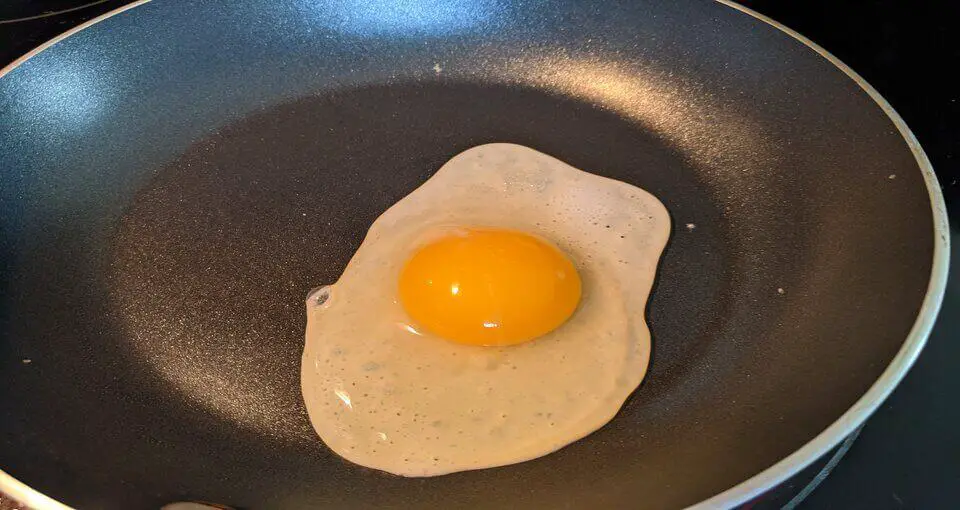Cooking over easy eggs isn’t as easy as it sounds, pun intended! I have found a neat trick to help the flipping process. Along with what else it takes to get the eggs to turn out just right. Your first one might not be perfect, but I guarantee you can get it right after you know these things.
I have never seen this trick done before so we can call it a egg hack just for fun. Its pretty simple but makes the flipping part much easier. Don’t worry I will get to the hack here very soon.
First lets get the rest of the egg cooking process correct to help set you up for success.
Step 1: Heat The Pan
Just remember stick to a low temperature when cooking eggs. I actually set my stove top to the lowest temperature, granted you might need it a little warmer in the winter. But the ideal temperature is around 210°F – 260°F. The pan will build heat as you cook, just don’t let it go above 300°F by much.

Infrared thermometers are a great cooking tool for just about anything.
You can find the same one I use from Amazon here.
Step 2: Add Butter or Cooking Spray
I found when cooking over easy eggs its better to use butter or cooking spray. As oil tends to add more liquid to the eggs. Oil also splashes if you heat it up too much causing a mess. But you may find oil to work for you, just remember you don’t need much.
Adding butter also allows you to gauge the pans temperature if you don’t have a thermometer. The butter should melt slowly instead of foaming up.
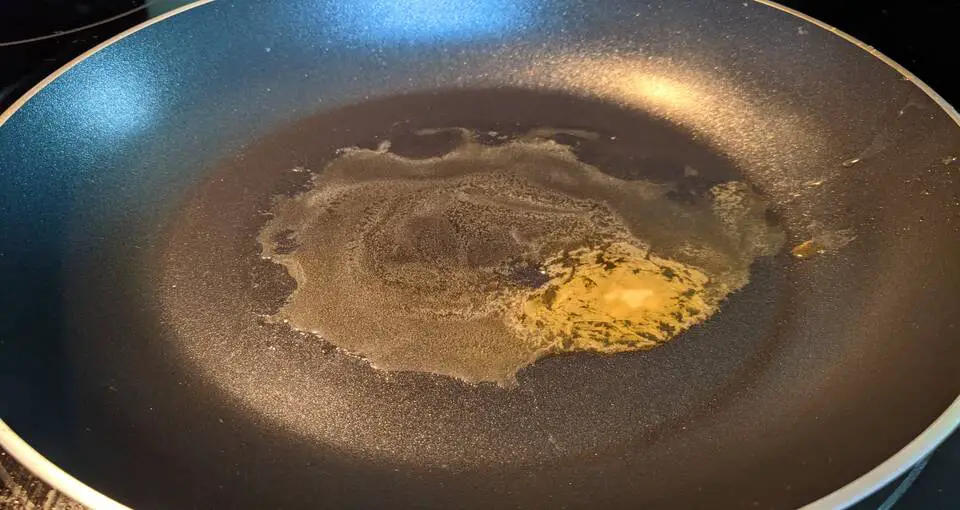
Step 3: Crack The Egg
This goes for all the egg styles. When cracking open the eggs don’t do it on the side of a pan. Crack them on a flat surface like your counter top. This will help to reduce the chance of any unwanted broken yolks early on as well as minimizing any pesky shells getting into the mix.
Also keeping your eggs cooler seems to make cracking them easier. I usually give the egg three taps down on the counter. One center tap then two others on each side to make a longer crack.
Step 4: Cook The Eggs
Again I find it best to cook the eggs low and slow. Rather than speed cooking them. It still doesn’t take very long to make them anyway. So after you have your egg crack and your ready to pour the inside onto the pan. Use both hands and carefully peel the egg apart but dump quickly.
This part does take some practice as I feel there is some technique to this as well. But its not too hard to mess up, you just don’t want to break the yolk at this stage.

After you poured in the egg cook for about 3 – 4 minutes. Let the runny liquid around the yolk turn white. Now your ready for the egg hack.
Step 5: The Hack
Now for the trick or hack I use to make the flipping part much easier. So you may notice your eggs has a thinner egg white section further away from the yolk. Well I find it best to simply remove these parts before you flip the egg.
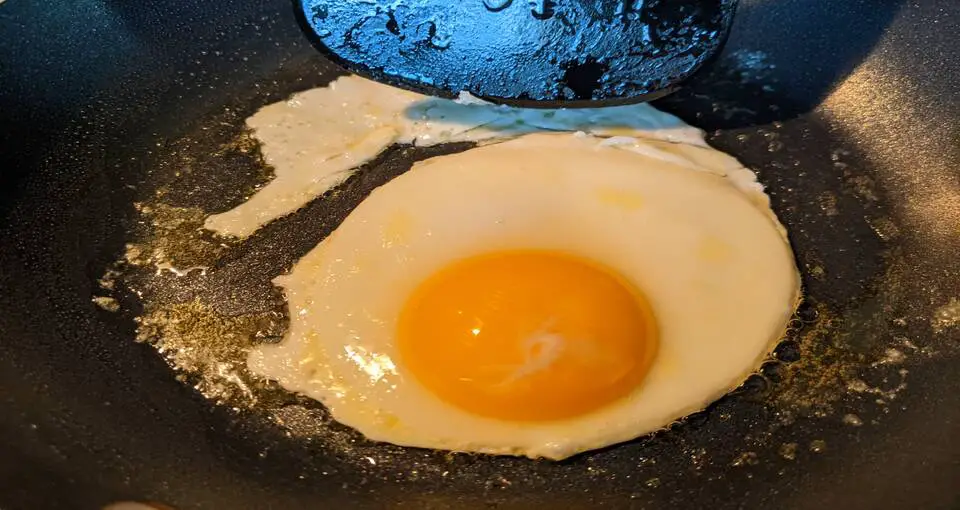
Use a plastic spatula so you don’t scratch your pan and run it along the sides trimming off those thinner egg white parts. They tend to get over cooked anyway.
Whats left is a meaty and round egg ready to be flipped. The hack makes flipping a lot easier as well, because the shape is rounded out.
Step 6: Flip Your Egg
Now your ready for the intimidating flipping part.
I found using a spatula is much easier than flipping the pan. At least for keeping the egg yolk from breaking.
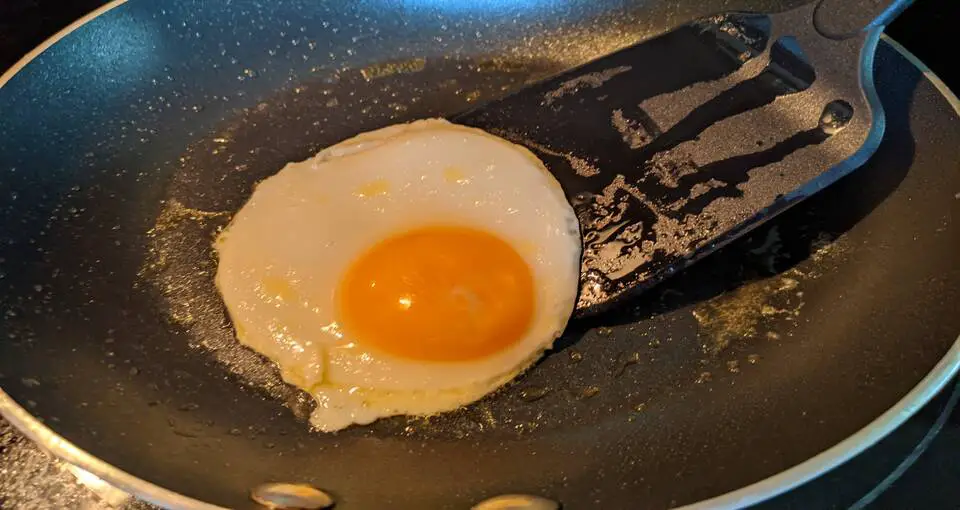
Step 7: Continue Cooking for a Minute After Flipping
The last step in the cooking process. Here is where you can choose how done you want your over easy eggs. If you want them truly over easy, let it cook for up to a minute. Maybe even just a few seconds. This will leave the egg yolk runny.
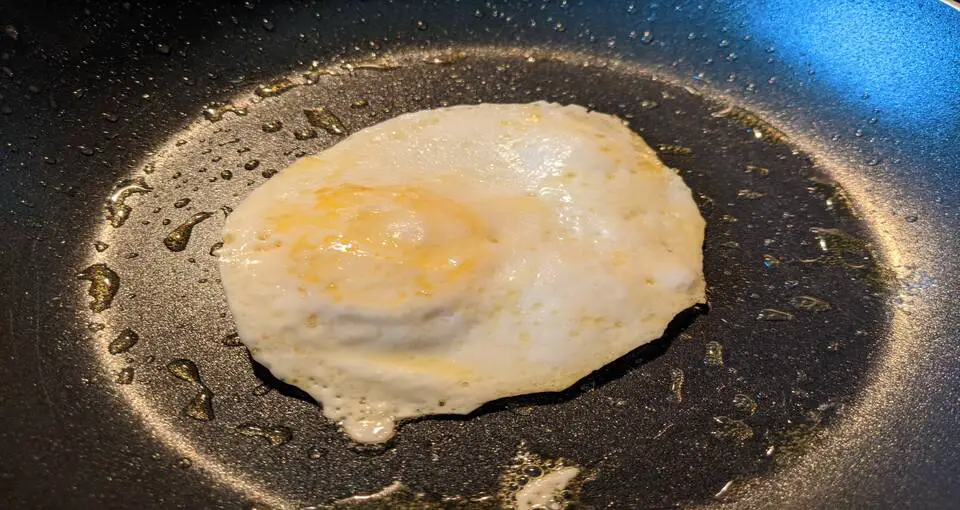
Step 8: Serve
At this point your ready to serve and eat. I might have cooked mine for too long, but there is still some runny yolk.
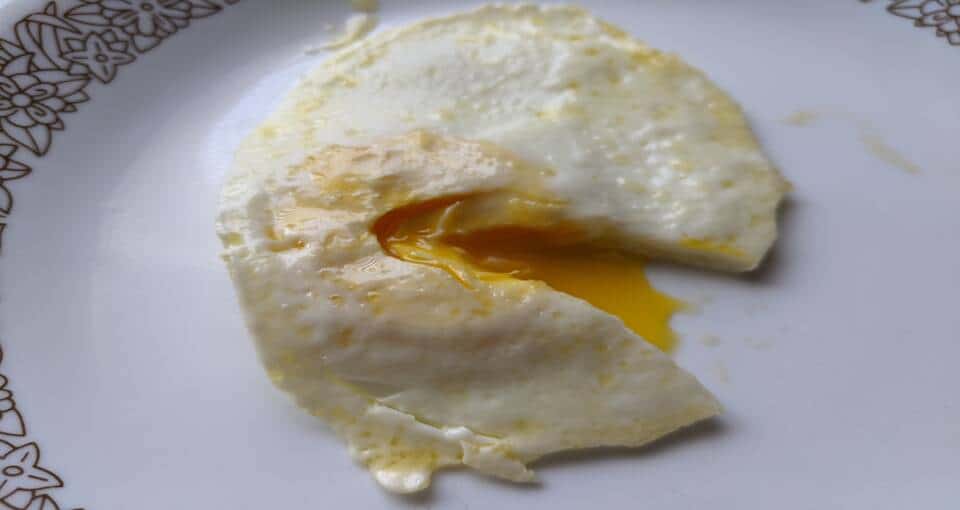
Other Ways To Cook Eggs
Being one of the culinary world’s most versatile foods is actually all it’s cracked up to be. The multitude of ways to cook eggs and all the amazing things you can do with them are endless.
Whether they are eaten for breakfast, dessert, or anything in between, they can be transformed into mouth watering masterpieces. From mayonnaise to crème brûlée to the humble over easy egg, there’s a treasure trove of ways to creatively enjoy these little devils.
It’s important when using minimal and simple ingredients that they be as fresh as possible. The older the eggs are the thinner and weaker the whites become and the less likely the yolk is to stay intact. Fresh is always preferable when it comes to the best possible taste, texture, and presentation.
You’ll have to break a few eggs to make some breakfast classics such as poached, scrambled, sunny side up, and over easy.
Over Easy, Medium, and Hard (flipped once)
Perfectly cooked eggs in this category all require the same cooking method and ingredients. The proper amount of cooking fat, the right cooking temperature, and a steady hand are all key. Most importantly you don’t want to break that luscious velvety yolk, until it’s time to eat it of course.
The only difference between these three styles is the length of time the egg continues to cook once flipped. For over easy cook an additional 20-30 seconds more, 1 minute for over medium, and 2 minutes for over hard.
One of the most common fats to cook eggs with is clarified butter. Clarified butter is made by heating whole butter so that the milk solids and water can be removed which makes it possible to cook at higher temperatures. The butter should always be unsalted so you can control the sodium content of the dish.
You can use a traditional sauté pan or a nonstick one. Either way there should be fat added to the pan for flavor and lubrication.
Make sure to cook the eggs on a medium heat. If the heat is too low the eggs could stick to the pan, and if it’s too high they could burn.
Lastly comes the intensely nerve wracking part of the flip. The perfect execution all comes down to this. Don’t break that yolk. If you’re confident in your flipping skills you can lift the pan up off the burner, swirl the egg around as it shouldn’t be sticking, angle the pan towards the floor a bit, and flick your wrist ever so slightly to complete the flip.
You can also use a spatula to assist with flipping the egg. Carefully scoop beneath the egg and get the entire egg onto your spatula. Then you can gently turn it over onto its other side back into the pan. If all goes well there should be no broken yolk and a beautiful cooked egg.
How To Flip An Egg Without a Spatula
Alternatives to Flipping: If you’re not feeling brave enough to attempt the flick of the wrist flip or the spatula flip, fear not, you have other options to yield the same result. One option is to baste the eggs in the cooking fat until the desired doneness. The other option is to add a small amount of water to the pan, place a lid on it and steam them the rest of the way.
Pro Tip: If you want to impress all of your friends and family with your spatula free flipping skills, the key is to practice. The easiest way to do this is with a piece of toast in a sauté pan. You simply hold the pan in one hand with the toast inside, and keep flipping the toast over as many times as you need to to get the hang of it. This will help to give you a feel for how much flick of the wrist you really need.
Sunny Side Up (not flipped)
The sunny side up style egg is truly the brother of the “over” style eggs. The cooking method, ingredients, and diligence are all the same. The only difference is there’s no flip required here.
Poached
Preparing poached eggs starts very simply by delicately placing your eggs in salted lightly simmering water and cooking them very gently until the egg whites become firm and hold their shape. A very classic dish where you’ll see poached eggs used is Eggs Benedict.
To help prevent any unwanted broken yolks you can crack the eggs into ramekins or cups and pour the eggs into the simmering water from there.
The fresher the eggs the less the egg whites will spread out too much before they coagulate, and the prettier your end result will be.
Pro Tip: Add a small amount of white distilled vinegar to your simmering water and take a spoon and swirl the water around like a tornado before delicately dropping the eggs in the pot. The vinegar as well as the swirling motion of the water will help to form the poached egg into a beautiful neat package.
Scrambled
Here’s your chance to finally break some yolks. There are a couple ways to properly cook scrambled eggs. If you prefer your scrambled eggs softer and more airy with a creamy consistency, you’ll want to stir them constantly over low heat as they cook. If you like your eggs firmer you should stir them less frequently as they cook.
You can use a fork or whisk to whip the eggs until smooth before placing them in your pan to cook. At this time you would also want to add your salt and pepper.
A sign that your final product is over cooked would be any moisture leaking out from the eggs.
Pro Tip: Add milk, heavy cream, any of your favorite unsweetened dairy free substitutes, or even water for light and fluffy scrambled eggs.

